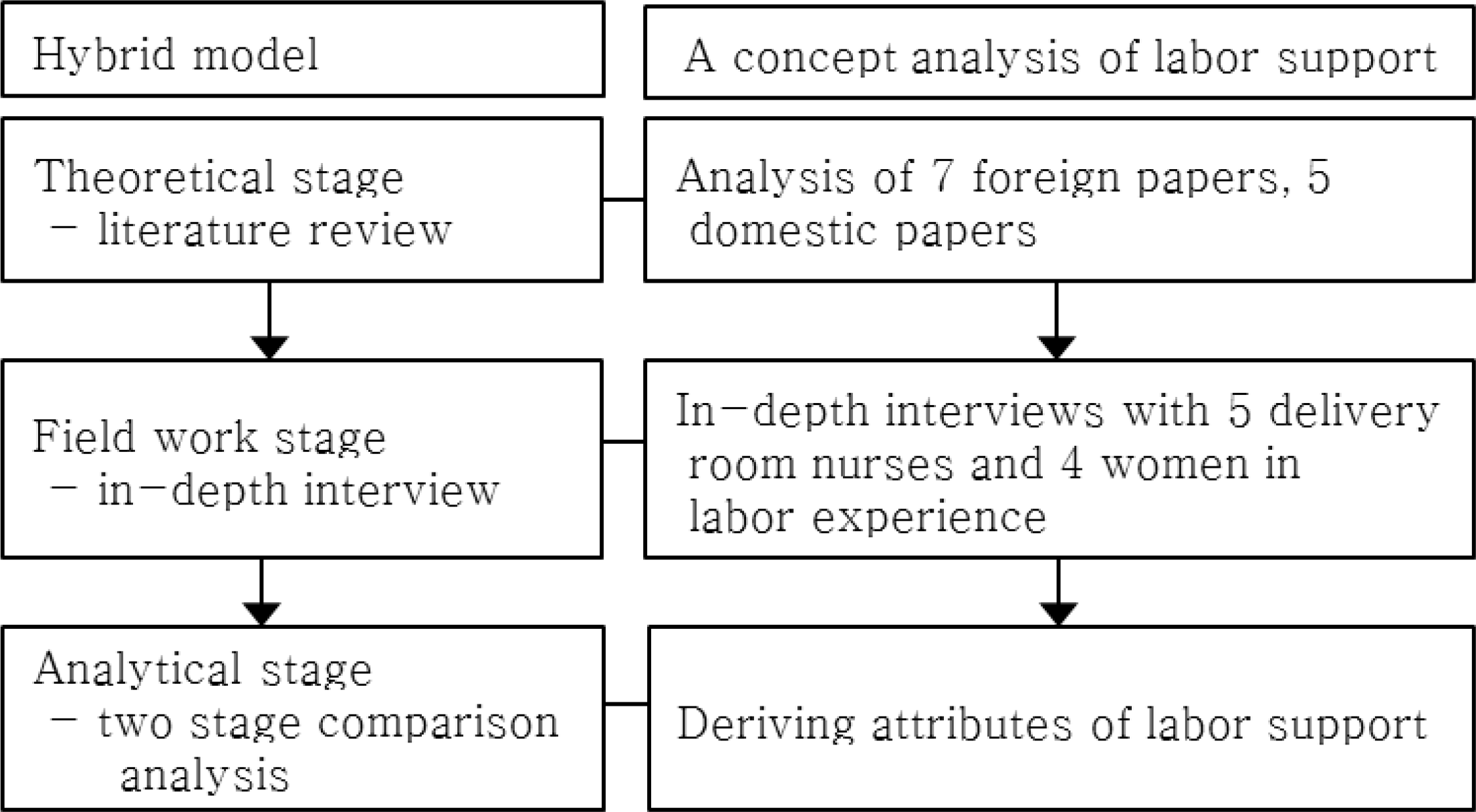Abstract
Methods
This study used Schwartz-Barcott & Kim's hybrid model to identify the main attributes and indicators. In the fieldwork stage, data were collected in Seoul and Chenmam, Korea. The participants were five nurses working in the delivery room and four women who delivered more than two children by vaginal delivery.
Results
The concept of labor support was found to have nine attributes and 23 indicators in two dimensions. For the physical intervention dimension, five attributes were derived. They were pain relief, selective use of technology, ambulation/positioning, physiological pushing, and increasing comfort. For the labor support practices dimension the attributeswereprovidinginformation, relief and encouragement, family support, and presence.
References
1. Khresheh R. Support in the first stage of labour from a female relative: the first step in improving the quality of maternity services. Midwifery. 2010; 26(6):e21–e24. https://doi.org/10.1016/j.midw.2008.11.003.

2. Hardin AM, Buckner EB. Characteristics of a positive experience for women who have unmedicated childbirth. The Journal of perinatal education. 2004; 13(4):10–16. https://doi.org/10.1624/105812404X6180.

3. Yeo JH, Chun NM. Influence of childbirth experience and postpartum depression on quality of life in women after birth. Journal of Korean Academy of Nursing. 2013; 43(1):11–19. https://doi.org/10.4040/jkan.2013.43.1.11.

4. Rubavathy P, Jenifer J, Stellagracy G, Kumar K. Effectiveness of social support during labour on behavioral response among primi mothers. International Journal of Nursing Education. 2015; 7(4):142–146. https://doi.org/10.5958/0974–9357.2015.00208.1.
5. Junge C, Soest T, Weidner K, Seidler A, Eberhard-Gran M, Gar-thus-Niegel S. Labor pain in women with and without severe fear of childbirth: A population-based, longitudinal study. Birth. 2018; 00:1–9. https://doi.org/10.1111/birt.12349.

6. Hodnett ED, Gates S, Hofmeyr GJ, Sakala C. Continuous support for women during childbirth. Cochrane Database of Systematic Reviews. 2013(7):).https://doi.org/10.1002/14651858.CD003766.pub5.

7. Hodnett ED. Nursing support of the laboring woman. Journal of Obstetric, Gynecologic & Neonatal Nursing. 1996; 25(3):257–264. https://doi.org/10.1111/j.1552–6909.1996.tb02434.x.

8. Park G, Choi J, Lee J, Jean B. Effects of doula support in LDR (Labor-Delivery-Recovery) on anxiety, labor pain, and perceived childbirth experience of primiparas. Journal of Korean Clinical Nursing Research. 2008; 14(3):87–97.
9. Middlemiss L. Doulas complementary or conflicting? Midwives. 2015; 18(4):66–68.
10. AWHONN. Continuous labor support for every woman. Journal of Obstetric, Gynecologic & Neonatal Nursing. 2018; 47(1):73–74. https://doi.org/10.1016/j.jogn.2017.11.010.
11. Choi YS, Jung MS. Factors affecting women's satisfaction with hospital environment following childbirth. Journal of Academia-Industrial Technology. 2013; 14(11):5627–5635. https://doi.org/10.5762/KAIS.2013.14.11.5627.

12. Hur MH. Effects of one-to-one labor support on labor pain, labor stress response, childbirth experience and neonatal status for primipara. Korean Journal of Women Health Nursing. 2001; 7(2):188–202.
13. Eom SY, Kim ES, Kim HJ, Bang YO, Chun N. Effects of a one session spouse-support enhancement childbirth education on childbirth self-efficacy and perception of childbirth experience in women and their husbands. Journal of Korean Academy of Nursing. 2012; 42(4):599–607. https://doi.org/10.4040/jkan.2012.42.4.599.

14. Lee YJ, Kim SH. Influences of husband's supports for during childbirth and attitudes toward husband's childbirth presence on women's childbirth experiences. Journal of the Korean Data Analysis Society. 2014; 16(6):3345–3359. http://uci.or.kr/G704–000930.2014.16.6.012.
15. Kim KS. The effects of aroma massage on stress and anxiety during delivery. Journal of International Union of Complementary and Alternative Medicine. 2011; 7(1):17–26.
16. Mortazavi SH, Khaki S, Moradi R, Heidari K, Vasegh Rahim-parvar SF. Effects of massage therapy and presence of attendant on pain, anxiety and satisfaction during labor. Archives Of Gynecology And Obstetrics. 2012; 286(1):19–23. https://doi.org/10.1007/s00404-012–2227–4.

17. Schwartz-Barcott D, Kim HS. An expansion and elaboration of the hybrid model of concept development. Rogers BL, Knafl KA, editors. editors.Concept development in nursing: foundations, techniques, and applications. 2nd ed.Philadelphia: W.B. Sau-ders company;2000. p. 129–159.
18. The National Institute of the Korea Language. Standard language dictionary [Internet]. Seoul: Author;2015. [cited 2017 October 30], Available from:. http://stdweb2.korean.go.kr.
19. Burgess A. An evolutionary concept analysis of labor support. International Journal of Childbirth Education. 2014; 29(2):64–72.
20. Barrett SJ, Stark MA. Factors associated with labor support behaviors of nurses. The Journal of perinatal education. 2010; 19(1):12–18. https://doi.org/10.1624/105812410X481528.

21. Corbett CA, Callister LC. Nursing support during labor. Clinical Nursing Research. 2000; 9(1):70–83. https://doi.org/10.1177/105477380000900106.

22. Sleutel MR. Development and testing of the labor support scale. Journal of Nursing Measurement. 2002; 10(3):249–262. https://doi.org/10.1891/jnum.10.3.249.52561.

23. Rosen P. Supporting women in labor: analysis of different types of caregivers. Journal of Midwifery & Women's Health. 2004; 49(1):24–31. https://doi.org/10.1016/j.jmwh.2003.10.013.

24. Adams ED, Bianchi AL. A practical approach to labor support. Journal of Obstetric, Gynecologic, & Neonatal Nursing. 2008; 37(1):106–115. https://doi.org/10.1111/j.1552–6909.2007.00213.x.

25. Lee SH, Lee MO. Characteristics, motivation of choice and childbirth experience of women who selected delivery at midwifery clinic. Korean Parent-Child Health Journal. 2013; 16:1–10.
26. Im HM, Kim JH. Methods and estimates of the reimbursement for the nurse midwifery center in the national health insurance. Korean Journal of Women Health Nursing. 2011; 17(4):328–336. https://doi.org/10.4069/kjwhn.2011.17.4.328.

27. Sosa G, Crozier K, Robinson J. What is meant by one-to-one support in labour: analysing the concept. Midwifery. 2012; 28(4):451–457. https://doi.org/10.1016/j.midw.2011.07.001.

28. Ross-Davie M, Cheyne H. Intrapartum support: what do women want? A literature review. Evidence Based Midwifery. 2014; 12(2):52–58.
Table 1.
Selected Papers in Theoretical Analysis Stage (N=12)
Table 2.
The Characteristics of Participants (N=9)
Table 3.
Dimensions, Attributes, Preceding Factors, and Consequences of Labor Support in Literature Review (N=12)
Table 4.
Dimensions, Attributes, Indicators of Labor Support in Field Work (N=9)
Table 5.
Dimensions, Attributes, Indicators of Labor Support in Final Stage




 PDF
PDF ePub
ePub Citation
Citation Print
Print



 XML Download
XML Download